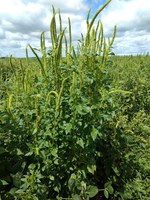NDSU Publications Help Land Managers ID Weeds
(Click the image below to view a high-resolution image that can be downloaded)
The number of weeds North Dakota land managers need to identify properly and control is growing.
To help them, North Dakota State University weed sciences professor Rod Lym has updated two publications: “Identification and Control of Invasive and Troublesome Weeds in North Dakota” and the pocket-sized “A Guide to North Dakota Noxious and Troublesome Weeds.”
He added Palmer amaranth, a particularly aggressive, hard-to-control weed, and narrowleaf hawksbeard, which has become especially troublesome in no-till cropland; cropland seeded with cereal grain, pulse and oilseed crops; hay fields; and along newly established pipelines. They are considered county-listed noxious weeds, which means individual counties require the weeds to be controlled within their borders.
The revised publications also reflect that houndstongue recently was upgraded to a state-listed noxious weed. That means it must be controlled statewide. It previously was a county-listed weed.
Houndstongue is one of 12 weeds on the state’s noxious weed list. It contains alkaloids that are toxic to cattle and horses.
“Identification and Control of Invasive and Troublesome Weeds in North Dakota” also includes common mullein for the first time. It’s a county-listed weed that’s often found in gravelly, dry soils, as well as waste areas and bottomlands.
In addition to new weeds, the publications contain updated control methods, including insects that provide biological control.
“A Guide to North Dakota Noxious and Troublesome Weeds” has symbols to indicate whether a weed is on a county or the state noxious weed list, biological or chemical control is available, a weed should not be removed by hand or can be removed with a spade or shovel, livestock can graze on it safely or the weed is poisonous.
Lym says these publications are a collaborative effort of NDSU and the North Dakota Department of Agriculture (NDDA). The NDDA paid for the publications’ printing, with a portion of the funding coming from the U.S. Forest Service.
To obtain copies of the publications, contact your county office of NDSU Extension or county weed officer. The publications also are online at https://tinyurl.com/NDSU-WeedIDControl (“Identification and Control of Invasive and Troublesome Weeds in North Dakota”) and https://tinyurl.com/NoxiousTroublesomeWeedsGuide (“A Guide to North Dakota Noxious and Troublesome Weeds”).
NDSU Agriculture Communication - Oct. 17, 2018
| Source: | Rod Lym, 701-231-8996, rod.lym@ndsu.edu |
|---|---|
| Editor: | Ellen Crawford, 701-231-5391, ellen.crawford@ndsu.edu |


